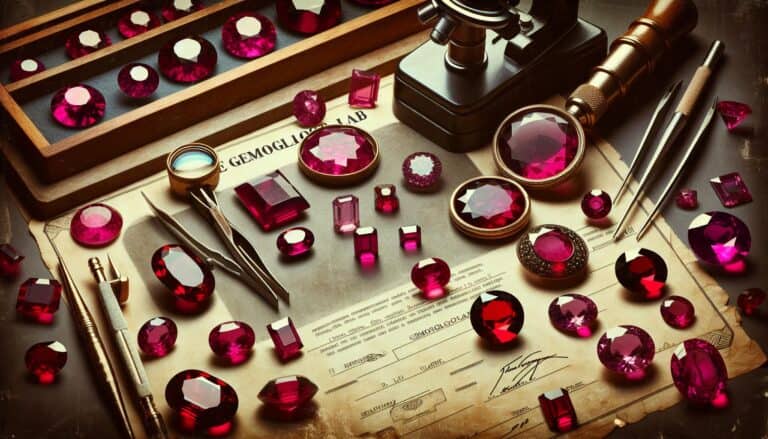Discovering the kaleidoscopic charm of ammolite is like uncovering a hidden gem of the fossil world.
You’re drawn to its iridescent allure, but how can you be sure it’s the real deal? Identifying genuine ammolite is crucial, whether you’re a collector, a jewelry enthusiast, or simply curious about this ancient treasure.
You’ll find that ammolite isn’t just any gemstone—it’s a rare, opal-like organic gem that captures the imagination with its vibrant play of color. Knowing the key characteristics that set authentic ammolite apart will arm you with the confidence to select the finest pieces.
Let’s dive into the world of ammolite and learn how to distinguish this mesmerizing mineral with ease.
To identify genuine ammolite, look for its radiant iridescence, vibrant color play, and elongated crystal form. Ammolite typically leaves a white streak, is non-magnetic, and ranks 3.5-4.5 on the Mohs scale. It should display double refraction and a specific gravity of 2.60-2.85.
How to Identify Ammolite Through Testing
When you’re on the hunt for authentic ammolite, knowing how to test for its genuineness is crucial. The tests listed below will guide you through the inspection process.
Visual Inspection
Start with a visual inspection. Authentic ammolite should display a radiant iridescence. Look for vibrant flashes of color that change as you move the stone in the light. High-quality ammolite typically features multiple colors, while lower grades might show only one or two hues. Check for any cracks or blemishes that could affect the stone’s value.
The Streak Test
The streak test can help determine the color trace of the mineral. To perform it, rub the gem across an unglazed porcelain tile and examine the streak color it leaves behind. Unlike harder minerals that might scratch the tile, ammolite should leave a faint streak without damaging the surface.
Magnet Test
Ammolite is not magnetic, so using a magnet can be a quick way to test for fakes. Hover a strong magnet over the stone. If it’s attracted to the magnet, it’s likely not ammolite.
Hardness Test
Ammolite’s hardness ranks at a 3.5-4.5 on the Mohs scale. Carefully scratch the stone with an object of known hardness. If the material scratches too easily or not at all, it may not be genuine ammolite.
Birefringence Test
This test examines the splitting of light as it passes through the gem. Place the ammolite under a polariscope to check for double refraction. If you notice this phenomenon, the likelihood of the stone being real ammolite increases.
Checking The Diaphaneity
Ammolite’s diaphaneity refers to its light transmission properties. Authentic ammolite ranges from transparent to opaque. Hold the gem up to a light source and observe how the light passes through, or if it does at all.
Single or Double Refraction
Use a dichroscope to distinguish between single and double refraction. Ammolite should exhibit double refraction. When looked at through the dichroscope, you should see two images of the back facet edges when you rotate the stone.
Refractive Index Test
The refractive index (RI) of ammolite typically falls between 1.52 and 1.68. Using a refractometer can yield precise measurements of the gem’s RI, which can affirm its authenticity.
Finding The Specific Gravity
Calculate the specific gravity (SG) by weighing the gem in air and then in water. The typical SG for ammolite lies between 2.60 and 2.85. Deviations from this range could signal a counterfeit.
Identifying Ammolite in the Field
When searching for ammolite in natural settings, keep an eye out for its typical hosts, such as dark shales or along riverbanks. Look for the tell-tale iridescent sheen that is a hallmark of this gemstone.
Recognizing Potential Ammolite Rocks
In the field, potential ammolite-bearing rocks often have a flaky, layered appearance. These rocks might show signs of the iridescence characteristic of ammolite on their surface. Breaking open suspected rocks may uncover ammolite layers inside, revealing the gem’s distinctive brilliance.
Physical Characteristics of Ammolite

Ammolite, a gemstone with a dazzling array of colors, is not just visually appealing but also distinct in its physical makeup. Recognizing these characteristics can help you differentiate authentic ammolite from imitations.
Iridescent Play of Color: Prime among ammolite’s features is its iridescence. This optical phenomenon causes ammolite to display a spectrum of colors, similar to opals. You’ll notice flashes of green, blue, red, and yellow, often in swirling patterns.
Layered Structure: Ammolite gems are composed of aragonite layers, derived from fossilized ammonite shells. These thin, horizontal layers stack to create a unique ‘laminated’ effect. If you’re inspecting a specimen, look for these fine strata which are a telltale sign of genuine ammolite.
Organic Origin: Unlike minerals that crystallize from inorganic processes, ammolite origins are tied to once-living organisms. This organic nature is evident in the presence of fossilized features within the stone, such as suture patterns typical of ammonite shells.
Fluorescence: Under ultraviolet light, authentic ammolite often exhibits a soft fluorescence, which can add another layer of verification when you’re identifying the real deal.
Remember, alongside these unique physical traits, you’ll want to refer back to the detailed tests previously discussed, enhancing your ability to authenticate ammolite with confidence. Keep these characteristics in mind as you examine potential ammolite finds or purchases.
How Are Ammolite Formed?
Ammolite’s unique formation process is a tale as old as time. You’ll find that these gemstones originate from the fossilized shells of ammonites, ancient creatures that thrived in the world’s oceans millions of years ago. Pressure and mineralization played pivotal roles in transforming these shells into the captivating ammolites you seek today.
- The first step in the formation involved the deposition of ammonite shells onto the sea floor when they died.
- Over time, the sediments covered the shells, compressing them under substantial weight.
- The next stage of the transformation was characterized by mineral-rich waters seeping through the sediments. Minerals like aragonite from the original shell contributed to the stunning colors of ammolite along with additional minerals introduced by the water.
As the earth evolved, geological activities such as tectonic shifts lifted these former seabeds, exposing them to the forces of erosion. It’s in places like the Rocky Mountains of North America, specifically the Bearpaw Formation, where the majority of ammolites are mined. These stunning gemstones are a geological testament, linking you to a past that spans back over 70 million years.
Understanding these formation processes hones your ability to appreciate ammolite beyond its physical beauty, turning every piece you come across into a historical artifact that echoes the legacy of Earth’s natural history.
Preparation for Ammolite Hunting
Before embarking on your ammolite hunting adventure, it’s crucial to prepare adequately. Proper preparation ensures not only a successful expedition but also your safety as you navigate the terrains where these gemstones are found.
Gathering the Right Tools
Your toolkit is your best ally in the hunt for ammolite. Here’s what you should include:
- Rock hammer: Essential for chipping away at sediment and extracting potential finds.
- Chisel and Pick: These tools help you delicately unearth embedded stones.
- Safety glasses: To protect your eyes from flying debris.
- Gloves: A sturdy pair to safeguard your hands.
- Bucket or a backpack: To carry your finds.
- GPS device or a map: Keep track of your location, so you don’t get lost.
- Magnifying glass: To inspect stones closely for ammolite characteristics.
Having the right tools not only makes the process easier but also increases your chances of uncovering a piece of Earth’s natural history.
Safety Considerations
Your safety should always be a priority. Keep these guidelines in mind:
- Wear appropriate clothing: Durable, weather-appropriate attire is necessary for protection against the elements and rough terrain.
- Footwear: Supportive boots with grip can prevent slips and falls on uneven ground.
- Tell someone: Always inform someone of your whereabouts and expected return time.
- Stay aware of wildlife: Carry bear spray if you’re in an area where bears are common.
- First aid kit: Include basic supplies for any minor injuries you might encounter.
By taking the proper safety precautions and gathering the necessary tools, you’ll be well-equipped for a productive day of ammolite hunting. Remember, the key is to be thorough in your search and always respect the natural environment you’re exploring.
Handling and Care of Found Ammolite

Once you’ve successfully located and extracted ammolite from the earth, it’s essential to understand the proper techniques for handling and care. These vibrant gems require meticulous attention to preserve their iridescent qualities and prevent any damage.
Cleaning Ammolite
Your first instinct might be to wash off any dirt or debris immediately, but with ammolites, it’s crucial to proceed with caution.
- Begin by gently brushing the surface with a soft-bristled brush to remove loose particles.
- Use lukewarm water to avoid thermal shock. Cold or hot water can cause fracturing.
- Avoid harsh chemicals and detergents which can strip the natural oils and luster.
- Pat the ammolite dry with a soft, lint-free cloth, avoiding any vigorous rubbing or scratching.
Remember, ammolites are delicate and rank only about 3.5 to 4.0 on the Mohs hardness scale, making them susceptible to scratches.
Storing Ammolites
Safeguarding your ammolites from the elements is just as important as the initial find.
- Wrap each piece individually in a soft cloth or place it inside a padded jewelry box.
- Keep ammolites away from direct sunlight; prolonged exposure can fade the brilliant colors.
- Ensure a consistent and moderate environment; extreme temperatures and humidity levels can cause harm.
- For enhanced protection, consider applying a clear sealant or stabilizer, especially if you plan on setting the ammolite in jewelry.
By treating your ammolite treasures with detailed care, you can maintain their mesmerizing beauty and enjoy your discoveries for years to come. Whether you’re an avid collector or a first-time hunter, respecting the fragility and value of these unique stones is key to their preservation.
Conclusion: Confirming Ammolite is Real
You’ve now got the know-how to identify ammolite, ensuring that what you’ve found is a true gem.
Armed with the tips on proper cleaning and storage, you’re all set to maintain your ammolite’s luster and value. Remember, treat your ammolite finds with the care they deserve, and they’ll continue to mesmerize with their iridescent beauty for years to come. Your newfound knowledge not only enhances your collecting experience but also preserves the legacy of these ancient treasures.
Happy hunting!






![Kansas Rockhounding Sites in [year]: Best Spots & Treasures](https://observationhobbies.com/wp-content/uploads/2024/01/MEpyAlU09VN0IV9zhK62K-768x439.jpg)
